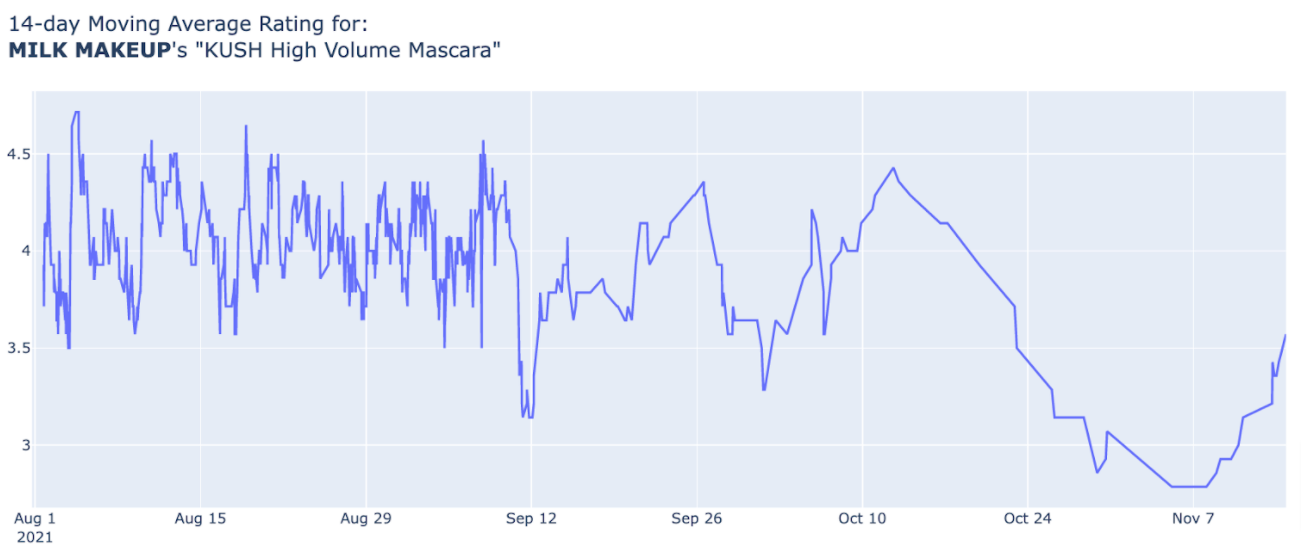Business Use Cases
Business use cases with analyses are illustrated here.
On this page
- Five Business Use Cases
- Case 1: Tweet Sentimental Analysis Using TextBlob And NLP
- Case 2.1: Key Performance Brand Level
- Case 2.2: Key Performance Product Level
- Case 3: User Journey On Demo App Built On Tkinter (Python GUI)
- Case 4: Competitor Lookup
- Case 5.1: Customer Demographic and Attribute Distribution
- Case 5.2: Average Product Rating Over Time
- Case 5.3: Product for Specific Area of Concern
- Case 5.4: Top Products with Certain Attributes In Mind
Five Business Use Cases

Case 1: Tweet Sentimental Analysis Using TextBlob And NLP
NLP powered tweet analysis
- Sentiment analysis is the task of determining the emotional value of a given expression in natural language.
- Using collected tweets data per brand, perform sentimental analysis using - TextBlob
- Textblob (NLP Api) sentiment analyzer returns two properties for a given input sentence:
- Polarity: -1 is negative, +1 is positive sentiment
- Subjectivity: Subjective sentences generally refer to personal opinion, emotion, or judgment. Use polarity to assign word to each tweet: positive, negative and neutral
Clients can get insights from sentimental analysis of customers’ tweets.
- This graph shows the relative perception of brands based on tweet sentiment analysis
- Again, tweets are processed through an NLP model and classified if they were either: Positive, Neutral or Negative in sentiment
- For example, GLAMGLOW has received a lot of flak and bad press KORRES on the other hand has generated a lot of positive buzz on Twitter
Case 2.1: Key Performance Brand Level

- This graph shows the relative perception of brands based on tweet sentiment analysis
- Again, tweets are processed through an NLP model and classified if they were either: Positive, Neutral or Negative in sentiment
- For example, GLAMGLOW has received a lot of flak and bad press KORRES on the other hand has generated a lot of positive buzz on Twitter
Case 2.2: Key Performance Product Level

- This graph shows the relative perception of brands based on tweet sentiment analysis
- Again, tweets are processed through an NLP model and classified if they were either: Positive, Neutral or Negative in sentiment
- For example, GLAMGLOW has received a lot of flak and bad press KORRES on the other hand has generated a lot of positive buzz on Twitter
Case 3: User Journey On Demo App Built On Tkinter (Python GUI)

- User opens the application
- User searches for the interested product
- Search query result is displayed with brand logo and product photo
Shows the product’s ingredients and whether it contains harmful ingredients with a kind warning.
Users can get comprehensive information on interested products’ ingredients and whether it contains any harmful substance
Business Case Convert users to purchasing products by becoming go-to place for searching cosmetics products Affiliate revenue is sizable with growing user base
Case 4: Competitor Lookup

- Used Tableau to create a Brand Dashboard
- Dashboard uses brand name as a filter so that the user can choose which brand to look into
- Dashboard contains information like brand description and their products
- Dashboard also shows the brand logo and its official website if present
Case 5.1: Customer Demographic and Attribute Distribution
Clients can understand customers based on user review analysis.
- The brand’s main audience are between 18 to 34, although there are also customers from other age bands
- Most customers are lighter skinned
- Eye color distribution show that they have an area of improvement where they can release products that may match better with gray eyes
Case 5.2: Average Product Rating Over Time
Some products might be seasonal.
- Product review started off strong, but tapers off with slower frequency of review and dropping average rating value
- Might suggest that product is not as good as expected or longer-term issues with the product that wasn’t immediately apparent (e.g., weather incompatibility)
Case 5.3: Product for Specific Area of Concern
Review data can tell clients where users find the product most useful.
- “Purity Made Simple Cleanser” was made for acne problems in mind
- May also help with aging skin
- Not a good fit for customers who are looking to fix stretch marks or sun damage
- Brands can know consumers’ pain points and use insights to target marketing and improve formula to strengthen the product positioning
- Consumer can make better informed decision about their intended purchasing before paying
Case 5.4: Top Products with Certain Attributes In Mind

- For undecided customers, they can first look up for items that are often used by others who share similar attributes
- For example, they may have a “combination” skin type, light skin tone, and blue eye color
- This insight can help them choose the right product in a specific category (e.g., foundation)
- Graph shows each product’s “love” rating (a measure of how many times customers “love” a product), and their numeric rating